Friday 29 June 2012
The Antelope Jackrabbit: Large Ears And High Leaps
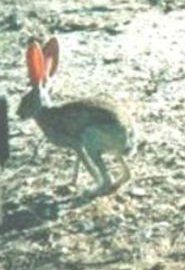
The
Antelope jackrabbit (Lepus alleni) is a species of North American hare. Known for its ability to make high leaps, and ears that are especially large, the mammal is named after the fast, long-legged antelopes of Africa.
Antelope jackrabbits can run as fast as 45 miles (72 km) per hour, and can jump as high as five-feet (1.5 m) and as far as 22-feet (6.7 m). The Antelope jackrabbit watches for predators from almost any angle; its large eyes are placed high and back enough to provide almost a 360-degree view. Predators include coyotes, rattlesnakes,
bobcats and cougars. Once spotted and chased, the Antelope jackrabbit will race from its enemy, purposely flashing its white rump to confuse the predator.
Weighing between nine to 10 pounds (4.5 kg), the Antelope jackrabbit ranges from 18 to 24-inches (45 to 60 cm) in length, with a tail up to four inches (10 cm). The whitish ears, which grow as long as eight inches, help regulate body temperature by either transferring heat back to the air as needed or maintaining body warmth in cold weather. The ears also become erect when the Antelope jackrabbit is alarmed.
The Antelope jackrabbit is commonly found in northern Mexico and Arizona in the United States, and has been observed along the border of New Mexico and portions of southeastern California. Due to its stable population, the Antelope jackrabbit is not considered at risk of endangerment. Its natural habitat is grasslands at moderate elevations or deserts where grass grows under shrubs.
Because it is nocturnal, the Antelope jackrabbit spends the day resting, usually in the shade of grass, brush or cactus where temperatures are lower than the open desert. Blending in with its surroundings, the jackrabbit uses camouflage to evade detection.
Herbivorous, the Antelope jackrabbit eats green grass, desert vegetation and cactus pads, usually feeding at dusk and dawn. The Antelope jackrabbit will stand on its hind legs to reach higher branches of vegetation such as mesquite. Cacti routinely serves as a moisture source, as water is not available nor actively needed.
The breeding season runs from January to October, with a gestation period of roughly 42 days and the possibility of seven litters per year. Litter sizes average from one to five. Unlike rabbits, which are born blind, the Antelope jackrabbit young are born fully haired and with eyes open. Young are also born able to hop.
You can help spreading the word about this animal by liking it on facebook
Permanent Link
Thursday 28 June 2012
Arapaima - South America's Living Fossil

The
Arapaima (Arapaima gigas) is known as a living fossil because there exists a fossil of this species or one very close to it in Colombia. Living fossils often are only known because of the similarity in the fossils already found, because they have no other living species that resemble them. It is usually speculated that living fossils like the arapaima were around during catastrophic events in prehistory that led to the extinction of many other species.
The arapaima’s origins are said to be in Brazil, where it thrives in the fresh water of the Amazon basin. It is also found in other parts of South America, such as Argentina. Thailand and Malaysia also are home to the arapaima, where they live in local lakes, though they were introduced to these countries and are not native to them.
Out of all of the freshwater fish in the world, the arapaima is one of the largest. This fish can reach 2 meters in length or 6.6 feet, and can weigh more than 100 kilograms, or 220 pounds. Some can even grow to be 2.5 meters or 8.2 feet long. It is a unique species because it needs air to breathe, so it survives best in the shallower waters of the Amazon. In deeper waters it can be seen coming to the surface to take in air.
People in the arapaima’s native region love its meat. The flesh of the fish has a reputation for being very tasty, and arapaimas are eaten frequently in Brazil. It is also sought after in South America for other uses, including those that are medicinal in nature. According to local folk traditions, the fish’s tongue has healing properties. Supposedly if you dry the fish’s tongue and prepare it with a certain native bark by adding both to water, this mixture will get rid of parasitic worms. Locals also fashion nail files out of the arapaima’s scales. As for its own diet, it is a fierce freshwater predator, eating not only other fish and crustaceans but even some small
birds.
Because it is so popular for both food and other uses, it is widely fished and has reached the Vulnerable stage on the extinction scale. If present trends as far as fishing rates and the destruction of its Amazon habitat continue, the fish will reach the Endangered stage on the scale.
You can help spreading the word about this animal by liking it on facebook
Permanent Link
Thursday 21 June 2012
Hairy-eared dwarf lemur

The
Hairy-eared Dwarf Lemur (Allocebus trichotis) is a nocturnal primate, the only member of the genus Allocebus of the family Cheirogaleidae. This species is endemic to
Madagascar. Hairy-eared Dwarf lemur has been found at the nature reserves of Mananara, Zahamena, and Vohidrazana in Madagascar. This species lives originally in the primary lowland rainforests.
The hairy-eared dwarf lemur is one of the smallest primates with a weight of only 80 to 100 g (3 -3.6 oz) and a length of 30 cm. It has a galago-like ear. This could mean that it is, together with other cheirogalieds, more closely related to the galagos and lorises than to the lemurs. This species has a relatively longer tongue than the Microcebus and Cheirogaleus specie. The overall pelage color for Hairy-eared Dwarf lemur is gray. It has a brown tail and a face with a white stripe running from the rostrum or nose to between the eyes as well as dark rings surrounding its eyes. Its ears have tufts of brown while its teeth structure and claws are sharp.
It was observed in captivity that males and females tend to groom each other by removing dead skin and parasites before leaving their nest at night. The hairy-eared dwarf lemur leaps frequently among branches of trees, they have been observed to leap more often than members of the genera Cheirogaleus and Microcebus. Although they typically forage and feed alone at night, these lemurs live in social networks with overlapping ranges, and they have occasional contacts mainly based on vocalizations and scent marking during the night. Due to small body size, most vocalizations are relatively high-pitched small-contact, alarm, threat, and range defense.
Interestingly, the hairy-eared dwarf lemur is one of the world's rarest mammals. This species was assumed to be extinct because no specimen had been seen from 1875 until 1966. It was rediscovered in 1966 on the east coast of Madagascar near Mananara. In 1989, two live members were found in the same vicinity, south of the Mananara River. As of 1997, it was still known only from eastern Madagascar near Mananara. The status has been changed from Critically Endangered to Endangered in 1996 due to the discovery of new subpopulations.
The hairy-eared dwarf lemur is trapped and eaten by local inhabitants. Deforestation of its habitat for agriculture and logging is also another reason why it has decreased in population.
You can help spreading the word about this animal by liking it on facebook
Permanent Link
Wednesday 20 June 2012
The Potto: The Nighttime Adventurer who moves Softly-softly
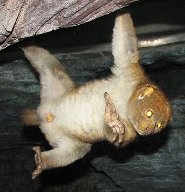 Potto
Potto (Perodicticus potto) is the name given to a family of strepsirrhine (wet, curly nostrils) primates known as Lorisidae. In some English-speaking parts of Africa, it is known as Softly-softly for the way it moves without making a sound. It is a relatively small animal, weighing in at about 3 pounds/1.5 kg and reaching an average length of 12-14 inches or 30-40 cm. It has a relatively small head in comparison to the rest of its body, suggesting a lesser intelligence.
There are several unique features to this animal’s anatomy. Three of the vertebrae in their neck have sharp points that almost pierce the skin and are used as a defense. If confronted, the potto will turn and hide its face and neck-butt the opponent. They do bite on occasion. The saliva of a potto has inflammatory properties, causing swelling at the site of the bite. Another notable feature is the opposable thumbs which help them to firmly grasp the branches of a tree. The index finger is considered to be a primitive feature that no longer serves a purpose. Pottos move slowly and quietly, always using at least 2 limbs to grasp a branch.
Pottos are nocturnal animals, moving around at night and sleeping in the leaves during the day. They typically live in the rainforests in tropical parts of Africa, very high up in the trees. This is the primary reason it has so few predators. They almost never come down from the trees, and no predators that can get as high as the treetops they inhabit. Birds of prey in this region are diurnal, hunting only during the day. The only real threat to pottos is to those who live near villages because they are hunted for bushmeat. Pottos themselves subsist on a diet primarily made up of fruit, tree gums, and insects, in that order. Some have been known to eat
bats, but this is not common.
These primates emit an odor not unlike the smell of curry from their scent glands located underneath the tail. The courting ritual is a mutual grooming session while hanging upside down. They lick and comb each other’s fur with their claws and teeth, marking each other with their scent glands. Mating is face to face and upside down. Once impregnated, the gestational period lasts for approximately 170 days, producing only a single offspring. A baby potto is not fully mature until 18 months of age.
The potto is Class B of the African Convention which only allows it to be hunted or captured with special authorization from the government. International trade is also strictly controlled. The only real threat to the pottos’ lifestyle is habitat loss stemming from aggressive logging and agriculture. They can live in any type of tree. But they can’t live anywhere without them.
Picture of the potto by
Ltshears at the Cincinnati zoo, licensed under
Creative Commons Attribution 3.0 Unported
You can help spreading the word about this animal by liking it on facebook
Permanent Link
Tuesday 19 June 2012
Black-footed cat - smallest cat living in the African desert
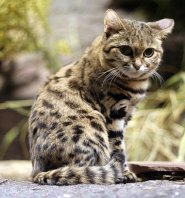
Among the different breeds of wild cat, the
Black-footed Cat (
Felis nigripes) is among the smallest. The male's weight is just 2.2 kilograms, and the female weighs even less, an average of 1.5 kilograms. Their body length is approximately 50 centimeters and shoulder height is 22 centimeters. The Black-footed Cat has a broad head, with a black line that runs across the cheeks from the outer corner of each eye. Its coat varies from sandy brown to a red-brown, and the pelage is spotted with dark patches. Its legs have horizontal stripes, the tail adorned with rings. They can only be found in South Angola, Botswana, Namibia and South Africa. The Black-footed Cats lives in an arid environment, and it is strongly believed that they can live without drinking water. They get what they could from the food, just like the
Sand Cat of Africa.
The Black-footed Cat lives in uninhabited burrows, covered and hidden by big boulders. Hunting is basically done at night, and their diet consists of rodents, ground squirrels, mice, small mammals, and as secondary choices- spiders and even reptiles. Actually, it is common for an individual to go after bigger prey, and store the carcass for future consumption. A Black-footed Cat is also capable of scavenging on the meat/flesh of dead mammals, a lamb for example.
These cats' litter size is one to four young, with a gestation period of 65 days, give or take. The newborns would attain "maturity" when they come to about 20 months. During times when they feel threatened, a male would emit a high-level "roar".
Interesting fact: Birds can be captured by Black-footed cats, it would jump into the air at the exact moment that the bird takes off...the sense of timing of these cats is highly-developed.
Picture of the Black-footed cat by
Asten, original
http://www.flickr.com/photos/asten/260095916/, licensed under
Attribution-Noncommercial 2.0 Generic
You can help spreading the word about this animal by liking it on facebook
Permanent Link
Wednesday 13 June 2012
The Blue-Fronted Amazon Parrot - colorful and camouflaged
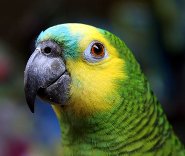
The
blue-fronted amazon (
Amazona aestiva) is a medium to large sized parrot, indigenous to south and central America. It is known for its bright green coloration, with a bright blue colored markings above the ceres or beak area. Around the head, the color may consist of bright yellow markings. Many people prefer to own this type of parrot for its excellent ability to speak and to mimic sounds. It also makes a good companion with proper training.
In the wild, the blue-fronted amazon tends to dwell in tropical rain forest regions of south and central America, where it strips the bark of trees to keep its hook bill trimmed. It populates regions of Brazil and Argentina in abundance. Its diet in the wild mainly consists of seeds and fruits. The size of the blue-fronted amazon is generally between 12-15 inches (30-38 cm) from the top of its head to the tip of its tail.
Although amazon parrots are excellent at dodging predators in the wild, they can become prey to larger
birds. Amazons do not become captured by predators very frequently however, due to the fact that they tend to perch in high trees and their green coloring is an excellent camouflage.
As a pet, the blue-fronted amazon may bond with one person exclusively, if it has been hand-raised and hand fed from a baby. If this bird is cared for properly and given a balanced and nutritional diet that includes fruits, vegetables, grains and protein, it should have a lifespan of about 50-60 years or more.
The blue-fronted amazon becomes sexually mature at about four or five years of age. These types of parrots generally mate for life, and will choose one partner for a lifetime. A clutch of babies typically consists of one to three.
Although this breed of parrot has been domestically bred in the United States for many years, it is considered to be an endangered species in its natural habitat of central and south America. Importing and smuggling this parrot from their native country is illegal and may pose certain health risks. Breeders who raise blue-fronted amazons in the States typically place an identification band on the bird's leg. This is to establish the bird is a domestically bred, and not wild-caught parrot.
These parrots are considered to be highly intelligent creatures. This is another attribute which makes them so desirable as pets. They are easily bored and need constant mental stimulation in the way of toys and a large cage or play gym perch. Most blue-fronts which are kept as pets prefer to spend time interacting with their owners and love to perch on a shoulder.
It should be noted that if kept as a pet, there are certain hazards that need to be avoided. Like all parrots, the blue-fronted amazon should never be given chocolate or avocado to eat, as it can be toxic or even lethal to them. Teflon or non-stick pots and pans which overheat can also pose a health risk factor and be toxic to pet parrots as well.
Picture of the blue-fronted amazon by Matthew Watts, licensed under the
Creative Commons Attribution-Share Alike 2.0 Generic license.
You can help spreading the word about this animal by liking it on facebook
Permanent Link
Friday 08 June 2012
Guatemalan Black Howler Monkey
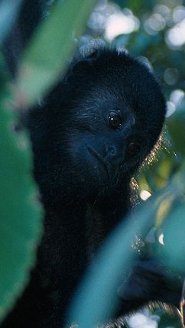
The endangered
Guatemalan Black Howler (
Alouatta pigra) (sometimes called the Yucatan Howler or Yucatan Black Howler) is one of many species of howler monkey, which is what is known as a ‘New World’ monkey. Its range is throughout the Yucatan Peninsula, and includes the areas of Mexico, Belize, and of course Guatemala. The Guatemalan Black Howler prefers to live in very lush areas, mostly sticking to all types of rain forests such as the semi-deciduous, lowland and evergreen. Of its cousins and relatives, the Guatemalan Black Howler is the largest, and is also one of the largest ‘New World’ monkeys (which include marmosets, owl monkeys, sakis, spider, and woolly monkeys). It weighs in at 25 lbs on average in males (11-12 kg) and 14 lbs for the females (6-7 kg). Their fur is usually black and their tails are very long, and prehensile (meaning it can grab and be used to hang from branches with). They also have specialized teeth for their diet of mostly leaves, along with the males possessing a larger hyoid bone located near the vocal chords, which enables their loud calls.
The Guatemalan Black is a diurnal howler, which means it is active during the day and it sleeps at night, as well as being arboreal, meaning it dwells in the trees most of its life. They are a social species that lives in groups up to ten members strong, which helps in alerting, foraging, and general upkeep through grooming. Some groups can be as large as sixteen, while larger groups are plausible, however at these sizes it is unlikely to function as well as a smaller group. Their diets consist of mostly leaves, and fruits, however they will snack on a flower here and there and their favorite tree of all is the breadnut, which provides most food during some seasons.
Not a particularly active species, the Guatemalan Black Howler would rather lounge about during the day; eating takes up a quarter of the day while moving locations for eating consists of only about a tenth of their daily activity. The rest of the day is devoted to socializing and grooming, with some other random antics. Females are old enough to have offspring by four years of age, while males may take up to eight years to reach maturity, and their total life-spans are an average of twenty years.
The Guatemalan Black Howler’s binomial name (its species and genus) is Alouatta pigra, the Alouatta’s as a genus make up most of the Howler Monkeys, which are the largest of the New World Monkeys with but a few possible exceptions. Alouatta is home to all of the howler monkeys (ten species and ten subspecies), and belongs to the subfamily Alouattinae. Alouattinae belongs to the family Atelidae which is one of the four families of New World Monkeys; this includes the howler monkeys, along with spider monkeys, woolly monkeys, wooly spider monkeys, and Yellow-tailed Woolly Monkeys. Atelidae belongs to the Parvorder Platyrrhini, which contains all New World Monkeys, and includes
Marmosets and Muriquis. Platyrrhini belongs to the infraorder Simiiformes, or ‘higher primates’, and this includes all New World and Old World monkeys from South America and Africa, and includes gibbons, great apes, and the family Hominidae of which we are members. Simiiformes belongs to the Suborder Haplorrhini, otherwise called dry-nosed primates; this includes all of the higher primates as well as
Tarsiers. Haplorrhini belongs to the Order Primates, which is all related apes, monkeys, lorids, galagos, lemurs and human ancestors. Primates are in the class of Mammalia of the phylum Chordata in the Kingdom of Animalia.
Fact
The Guatemalan Black Howler is sympatric with another species, the
Mantled Howler. Sympatric means that they share the same niche and territory, and encounter each other in the wild, they are also closely related.
Warning
The Guatemalan Black Howler is an Endangered Species, and is close to being classified as Critically Endangered if nothing is done to curb the loss of the species. In the next 30 years the IUCN expects to see a population loss of over 60%, making this species on the more endangered alive today. Major threats are habitat loss, poaching, and capture for use as ‘pets’.
You can help spreading the word about this animal by liking it on facebook
Permanent Link
Tuesday 05 June 2012
Northern Elephant Seal - Macho Man of the Sea
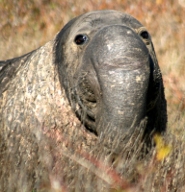
The male
Northern elephant seal (
Mirounga angustirostris), is an incredibly strong animal that dives deep, migrates far and has bloody battles to win the harems. These harems can be from 30 to 100 females and the winning male may have over 500 pups in his lifetime.
Named elephant seals because of their long elephant-like noses, the snout is used during breeding season for territorial defense. It is nearly a foot (33 cm) long when it is relaxed, and when it is inflated it is used to make very loud roars to challenge other males. These true seals, Phocidae, breed, give birth and molt off the coast of California and northern Mexico mainly on offshore islands. Males travel as far north as the Gulf of Alaska and the Aleutian Islands to find food, but the females feed further south and have been seen in Hawaii. They migrate twice a year and are the only mammals that migrate such great distances.
Northern elephant seals molt annually. It is called a "radical molt", because the skin comes off with the fur in large sheets. They congregate onshore in summer and molt at different times, starting with the babies in March and ending with the males in July.
The males do not eat for three months while they are on land and may lose up to 36% of their weight. Females fast for five weeks during mating and when she is nursing her pup. She mates just days before her pup is weaned. Males can weigh 2,300 kg (5,000 lb) and grow to 4 m (14 ft) and females grow to 3 m (11 ft) and weigh 640 kg (1,400 lb).
They feed in deep water on squid, pelagic red crabs, Pacific whiting, skates and also small sharks and rays. They remain under water for long periods, averaging 21 minutes for males and 17 minutes for females. From wounds and scars found on their bodies it is clear they are attacked by
orcas and large sharks, particularly the
great white shark. This is a significant cause of mortality in baby elephant seals.
The Northern elephant seal is protected in the US and Mexico from human exploitation. It almost became extinct in the late 1800s because it was hunted for its blubber, but legal protection allowed them to repopulate and they made the fastest comeback ever seen in any mammal. Currently, the population is estimated at over 150,000, approximately 84,000 in California and 35,000 in Mexico. Today, it is classified as Least Concern (LC) on the International Union for the Conservation of Nature and Natural Resources (IUCN)
Red List.
Picture of the male Northern elephant seal by Mila Zinkova, licensed under
GFDL
You can help spreading the word about this animal by liking it on facebook
Permanent Link
Friday 01 June 2012
The Lesser Egyptian Jerboa - an extreme jumper
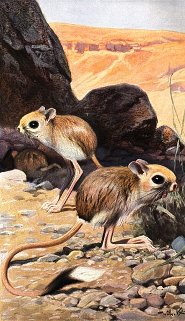
The
Lesser Egyptian Jerboa (Jaculus jaculus) is mouse-like in appearance with large eyes and ears with brown and gray fur with a lighter color belly. The animal is very small at only 95 to 110 millimeters long (3.74 to 4.33 inches) and 43 to 73 grams (1.51 to 2.57 ounces) in weight. Despite the Lesser Egyptian Jerboa's small stature, the creature can jump an impressive one meter (3.28 feet) from a standing position and 1.5 meters (4.95 feet) at top speed. It has even been known to travel up to ten kilometers (6.21 miles) in one evening in search of food. This is due to the animal's long bald tail except for a clump of fur at the end for balance and huge feet. Its posture and stride mimics that of a kangaroo. However, unlike a kangaroo, the Lesser Egyptian Jerboa is native to areas in central Asia, Iran, Israel, Sudan and north Africa. It is an especially common animal in Egypt, hence its name.
Since the Lesser Egyptian Jerboa lives in dry desert areas, it lives in burrows in the sand. The animal sleeps during the day and feeds on seeds, grass, grains and even some insects at night. Although the creature's main defense is its swift jumping abilities, it must remain vigilant against faster fox,
weasel, and snake predators. Safety may not even be found in its own burrow as these can also become home to scorpions and spiders.
Being a solitary creature, little is known about how it communicates with other Lesser Egyptian Jerboas. In captivity, these animals seem to recognize each other by smell by closing their eyes and touching noses together. They breed twice a year and have liters of three pups at a time. Although the mother will have close contact with her babies in the wild and stay with them in the burrow for eight weeks, breeding in captivity is never successful. For whatever reason, the mother simply refuses to touch her pups after their birth. Yet, Lesser Egyptian Jerboas brought into captivity can live up to six years and tamed as pets. Wild Jerboas can live up to four years.
You can help spreading the word about this animal by liking it on facebook
Permanent Link
 The Antelope jackrabbit (Lepus alleni) is a species of North American hare. Known for its ability to make high leaps, and ears that are especially large, the mammal is named after the fast, long-legged antelopes of Africa.
The Antelope jackrabbit (Lepus alleni) is a species of North American hare. Known for its ability to make high leaps, and ears that are especially large, the mammal is named after the fast, long-legged antelopes of Africa.
 The
The  The
The 
 Among the different breeds of wild cat, the
Among the different breeds of wild cat, the  The
The  The endangered
The endangered  The male
The male  The
The